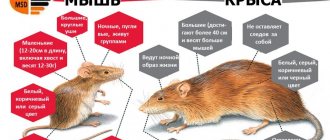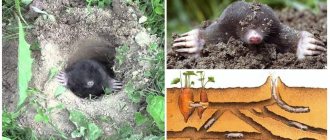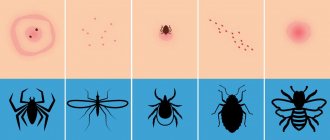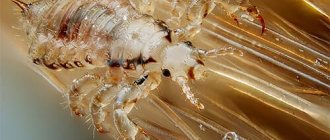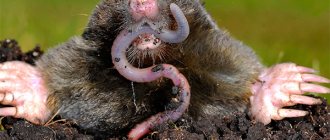Caucasian mole
Caucasian mole
is one of the varieties of ordinary moles. Found in the Caucasus and Turkey. Externally, the mole looks like a European one, but is smaller in size.
- The average body length of a mole is about 14 cm. Females are smaller than males.
- Weight no more than 90 g.
- Tail length is about 3 cm.
- The eyes are covered with skin and are hardly noticeable.
- The mole's nose stands out well on its elongated muzzle.
- The coat is thick, black, and becomes brown in the summer.
The Caucasian mole digs holes at a depth of 5-20 cm, leaving loose soil on the surface. In hot weather it goes deeper by 50-100 cm. It also builds a nest there. The main camera is placed under a tree or in a shady area. Numerous passages extend from the mole's nest.
Reproduction of moles begins at the end of March; cubs appear in April. They grow up extremely quickly. At the age of 1 month they reach the size of an adult mole, and at 60 days of their existence they leave the family to build their own nest.
Common or European mole
A real mole, which is often encountered by gardeners, gardeners, and wildlife lovers.
- The body size of the mole does not exceed 20 cm, the average dimensions are 15 cm. The body is oblong.
- The weight of an adult is about 120 g, the tail is no more than 4 cm long.
- The muzzle is elongated, the nose with splayed nostrils is clearly visible. There is nothing else that stands out on the head.
- Mole eyes with small slits without movable eyelids. The mole's vision is weak, but its sense of smell is well developed.
- The fur is soft, thick, short, black. The color on the abdomen is lighter. The tone changes somewhat depending on the time of year. In winter, the wool is the fluffiest and most beautiful. The animal sheds about 4 times a year. A photo of the mole can be seen below.
The mole animal has one striking distinctive feature - spade-shaped forelimbs with long claws. With them the animal digs the ground, screws itself into the passage, and pushes the soil out with its hind legs. In places where holes are dug, mounds are formed - molehills.
The mating season of the common mole begins in early spring and lasts until the end of May. Around June-July, the younger generation appears. There are about 9 moles in the litter. The female carries the cubs for about 30 days. The European mole gives birth only once per season. Carefully takes care of babies for about 2 months.
We suggest you read: The best remedy for bedbugs
The earth mole only appears outside to mate; this happens at night. The rest of his time is spent underground. Digs numerous passages and labyrinths. This type of mole feeds on earthworms, insects, pupae, caterpillars, and less commonly, slugs, lizards, mice, snakes, and frogs.
Reproduction
Sometimes moles break their solitary lifestyle to mate. Immediately after its completion, the male leaves the female. He does not help build nests for his young and does not participate in their upbringing. During the breeding season, females show increased aggressiveness towards individuals of their own sex.
Usually there is no more than one brood per year. The gestation period varies depending on the species from 30 (common moles) to 42 days (Eastern moles).
A new generation is born in nests. A brood consists of two to seven individuals. Initially they are naked and hairless, but after two weeks they become overgrown with fur. At three weeks of age, their eyes open. In the first month, babies' nutrition consists only of mother's milk. On the 35th day, moles leave their native nest and begin to look for a free area for themselves. During this period, many of them die under the wheels of cars or from predators.
Description and characteristics
The common and European mole is most often found in forests, meadows and fields. Where moles live, darkness reigns, so moles have no eyes. Some representatives sometimes have eyes; they are small and practically undeveloped; with their help, the mole can only distinguish night from day.
The mole spends almost all its time underground; it comes to the surface by digging molehills. Under the ground, a mole does not need vision; its other senses are heightened - smell, touch and very sensitive hearing. The mole's hearing organs are internal.
So what does a mole look like? This is a rather small individual, the length of which does not exceed 20 cm. The mole's muzzle without eyes is covered with hairs, with the help of which the mole senses the surrounding world. The animal's nose resembles a trunk. With its help, the mole gets its food. The animal is covered with black fur, the coat is velvety and soft to the touch. Most often this animal is found in black color, but representatives of this species are also ash and brown. The fur grows exclusively upward, no growth directions were noticed, that is, the fur does not lie either to the right or to the left, neither up nor down.
A mole's paws resemble hands. They have fingers, 5 in total. The fingers have long, dense claws that help the animal dig the ground and build tunnels. The animal's neck may not be noticed upon first inspection.
Typically, representatives of this species molt 2-3 times a year. The fur feels and looks best after the autumn shedding; before winter it grows thicker and longer to protect the animal from hypothermia in the winter.
Over the course of a lifetime, representatives of this breed grow up to 44 teeth.
Despite the average height, the weight of the animal is extremely small. Moles weigh only 180-200 grams. Males are slightly larger than females.
In the winter season, underground inhabitants do not go to bed; hibernation is not typical for them. During the day they sleep for 2-3 hours and go to bed a couple of times a day. They do not coexist with their relatives in the world; they share territory. They are able to feed on carrion and eat dead fellow tribesmen. There are practically no enemies underground. The danger for the mole is posed by terrestrial predators - foxes, martens. The underground dweller for these animals is the last in the food chain, because the mole emits an unpleasant odor for all other animals.
Skin parasites cause underground animals a lot of trouble, often leading to death
Habitat
To the question “where does the mole live?” there is a definite answer. Man, with his own hands, creates favorable conditions for the existence of moles. Every year, farmers cultivate millions of hectares of land, which the representative of this species takes advantage of. He “moves” into the already plowed land. This greatly facilitates the life of animals, because the soil in the fields is loose, so no special effort is required when digging tunnels and molehills.
Usually the mole goes underground by 6-7 cm, but sometimes the depth of the tunnel can reach 50 cm. Often underground representatives of the species build dwellings on the banks of reservoirs. They are excellent swimmers and love the water. They are not adapted to life on land; with such paws it is almost impossible to walk. The mole cannot crawl for reasons of its own safety, so as not to become easy prey for a predator.
Underground diggers dig complex tunnels, they are usually divided into:
- Residential tunnels, which often lead to a reservoir and communicate with each other.
- Feeding tunnels are dug to search for food.
How to prevent moles from appearing?
It is more difficult to fight than to take preventive measures. To prevent moles from migrating from neighboring or abandoned areas to a fertilized and landscaped garden, repellent measures can be carried out.
If an animal has tried the abundance of food in the garden beds, it is difficult to expel it from such a place. But you can scare them away by treating the perimeter of the fence with substances whose smell the mole does not like.
Tips on how to protect your area from moles:
- Make a foundation when installing a fence. Moles dig tunnels at a depth of 50 cm, you will have to deepen it by the same amount.
- Slate or mesh is dug along the fence to a depth of half a meter, and above the ground surface leave an edge at a height of 20 cm. This work is hard and costly, especially if the area is large.
- In the fall, you can scatter carbide under digging; from the action of autumn rains, it will begin to emit gas, which moles cannot tolerate. The smell will scare away their appearance, but when it disappears, the animals will try to return.
Burrow length
People, considering the performance achieved by this small builder, focus on the depth of the structure. But there is a more interesting factor that may capture the imagination. Agree, many people can bury themselves four meters into the ground in a straight line. But building tunnels whose length is many times greater than your size is a huge job.
So, this figure can reach up to three hundred and sixty meters (for a mole rat). And it is still unknown whether this is a record. The fact is that many species of moles have not been thoroughly studied. Science knows only general information about them. No one measured the length and depth of their holes. These include, for example, shrews.
Choosing a mole fur coat: small nuances
The hunting season for these animals is from October to November. The fur produced during these months is tall, even, smooth and shiny.
Fur coats are usually made from European or common mole - the most common type of this animal. In October-November, the color of the fur is coal-black with a noble silver tint.
When choosing a mole coat, you should pay attention to small nuances. High-quality products should not have any bald spots, this indicates that the animal was caught not during the hunting season, but during the molting period
The quality of Caucasian ridge fur is highly valued: these skins are velvety, with short but thick fur.
Above in the photo of a mole fur coat made from this type of underground animal, you can see that the fur is short, its length is no more than 1 cm. One cannot help but notice the ash-gray color with an unusual blue tint.
However, it is not so easy to buy a product made from undyed mole fur; the skins are almost always dyed in different colors, which significantly reduces the service life of the material.
Mole coats cannot be called warm, but they have a noble appearance. As you know, attractiveness is often the deciding factor when purchasing such a product.
Is it possible to get rid of moles with the help of cats and dogs?
When using domestic dogs and cats as mole hunters, certain nuances must be taken into account:
- Only an adult and mature animal can pose a serious threat to moles;
- First, you should carefully observe the mole tunnels, and as soon as the animal begins to move along them, bring a dog or cat to this place. This will probably awaken the hunting instinct in the animal;
- When using animals to catch moles, do not treat holes with toxic substances.
Models
Despite the fact that it is very difficult to sew a mole fur coat, there is a huge variety of them on the product market.
Here you can find:
- classic cross-cut fur coat;
- short autolady;
- model with a hood;
- with three-quarter sleeves.
Of course, due to the length, the price varies greatly. And not every fashionista can afford to buy a long mole fur coat.
You can often find a cross-cut mole fur coat, and this is understandable. Because The skin of this animal is very small, so sewing it into a whole product will be very problematic.
But the cross-cut fur coat will be sewn not from a single piece of fabric, but from individual skins. This results in a product with even horizontal stripes.
Also, not only fur coats are made from mole skins, but also jackets, vests and hats. Because The animal's fur is quite cold, but very velvety and soft; it is often used to make collars.
What is the difference between a mole and a mole rat?
- Animals belong to different orders: moles belong to the order of insectivores, mole rats belong to the order of rodents.
- Moles are carnivorous and feed mainly on invertebrates (earthworms, beetle larvae). Mole rats eat underground parts of plants: roots, tubers, bulbs.
- Mole rats dig the ground with large incisors and push it to the surface with their heads. Moles dig and push out soil with their front paws.
- Mole rats are larger than moles: their body sizes vary from 13 to 35 cm, and their weight can reach 700 g. The largest mole, the greater mogera, weighs 300 g and reaches a length of 21 cm.
- The fur of moles is painted in dark colors: black, dark brown, dark gray and their variations. Mole rats are much lighter in color. Their color is dominated by gray, yellowish, brownish and ocher tones.
- Moles have a small tail, ranging from 2 to 10 cm in length. In mole rats, the tail is vestigial and not noticeable from the outside.
- Moles are not blind, unlike mole rats. They see, although poorly. Moles have small eyes, but are covered by skin only in some species. The eyeballs of mole rats are large, but are always located under the skin.
- The habitat of moles is wider geographically: moles live in Eurasia and North America, and gravitate towards forest or forest-steppe zones. Mole rats live in the southern and eastern regions of Europe and Western Asia, preferring steppes, deserts and semi-deserts, and sometimes forest-steppe.
On the left is the European mole (lat. Talpa europaea), on the right is the common mole rat (lat. Spalax microphthalmus). Left photo credit: Valery91Thunder, CC-BY-SA. Photo on the right: Vivan755, CC BY-SA 3.0.
Reproduction
The breeding process occurs every year, and the timing of gestation for each species is different. The Siberian mole is characterized by the fact that it has a period when the embryo freezes for some period and stops developing. That's why:
- European moles mate in March-April and offspring are born after 35-40 days. Cubs are born blind and naked. Each litter contains from 3 to 9 moles, which weigh no more than 3 grams. Some adults (up to 20%) can become pregnant a second time. After a month and a half, the young leave the nest.
- Siberian moles mate in the summer, but the female gives birth to young the following spring. In this case, the female’s pregnancy lasts almost 270 days. Each litter contains from 3 to 6 moles. Already in June they become adults and leave the nest. In this case, females become sexually mature only the next year, and males only in the second year.
- The blind mole mates in February/March, when there is still snow on the ground. After a month, from 1 to 5 moles are born. After a month they become independent and leave the nest.
- The Caucasian mole also mates in February, and mole babies are born in March. After 40 days, no more than 3 individuals will already become adults and independent.
Despite low fertility and reproduction only once a year, the number of moles on the site is increasing at a rapid pace. Due to the fact that moles live in the ground, no predators can reach them.
The lifespan of moles depends on their species, although we can safely say that their average lifespan ranges from 4 to 5 years.
Reviews from summer residents
We set some homemade traps, but they were of very little use. It’s a feeling that the mole senses these traps and avoids them, or something like that, since not a single one was caught that way. It’s hard for me to explain the design of the trap; my husband made them, he knows.
Regina
https://farmerforum.ru/viewtopic.php?t=617
A very good way to get rid of moles is to get a cat. When the neighbor cats started visiting me, in the first summer they caught a lot of moles, and the rest left and went to the neighbors. Now moles appear, but in minimal numbers; in the summer they are caught by cats and cats, and we live quietly all summer. And since they are on the site and doing their business, then, apparently, there remains a smell that scares away the moles. By the way, the number of moles among our neighbors has also decreased. But we must admit that cats themselves are also pests when there are a lot of them and they are neighbors.
Julia
https://farmerforum.ru/viewtopic.php?t=617
Yes, now it seems that it is no longer a problem to fight moles - such a spinner is sold in stores, it chirps loudly. From this sound the moles not only leave, but run away. And they are sold in all flower shops - where there is fertilizer, flower pots, etc. She sticks herself into the hole as deep as possible. And there it starts to chirp. The moles will leave. There are such things both more expensive and cheaper. Of course, more expensive is better. My friend took everyone out. Although he has both dogs and cats on the property.
Natalia N.
https://farmerforum.ru/viewtopic.php?t=617
No drugs helped us, they called specialists who installed some kind of contraption, maybe a repeller, or something else... After that, it was still pah-pah...
IrinaIrina
https://forum.osadovod.ru/threads/borba-s-krotami.15/page-2
And as soon as I arrive at the dacha in the spring, I place these metal poles with beer cans all over the site. They rumble from the wind and the vibration is transmitted to the ground. Only if the wind is too strong, light cans may fall from the tubes. Actually, this is what happens in winter - you arrive, and they are all lying on the ground. But in March I hung it again and no more new piles of earth seemed to appear.
Igor V.
https://forum.osadovod.ru/threads/borba-s-krotami.15/page-2
I throw a 1.5-2 cm sulfur bomb into the hole, set it on fire and blow air into it with a small fan. Acrid smoke goes along all the passages and comes out of very unexpected places, dispersing all living things far and for a long time. It’s not my fault who didn’t hide.
uncle Vova
https://www.forumhouse.ru/articles/garden/6683
Recipe for “Cake “Mole Mink””:
Beat softened butter with 100 g of sugar and vanilla. Separate the eggs into yolks and whites and add one yolk at a time to the butter mixture, continuing to beat.
Add soda, slaked with vinegar, cocoa and flour, mix everything
Slowly pour in the milk until the dough turns out like thick sour cream.
Beat the egg whites with a pinch of salt until stiff peaks form.
Add the whites to the dough and place in the oven, preheated to 200 C, for 25-30 minutes until ready.
Prepare gelatin as indicated in the instructions. Take 1 banana, 100 g of sugar, cottage cheese and 2 tbsp. spoons of yogurt, grind everything in a blender
Mix the finished gelatin with the remaining yogurt, and then pour everything into the curd mixture. You can sprinkle everything with chocolate chips. Mix everything and put it in the refrigerator for 5 minutes so that the gelatin sets a little.
We take out our finished sponge cake and cut out the core from it, leaving the bottom and sides.
We lay out the bananas, you can whole them or cut them into 2 parts. I cut them, if whole, then you need to take 2 times more bananas.
Spread our yogurt mixture on top of the bananas, forming a small mound.
Crumble the biscuit on top, the one that was taken out of the middle. The cake is ready, put it in the refrigerator for at least 4 hours, and preferably overnight. You can sprinkle with cocoa before serving.
This is how the cake looks when cut.
Bon appetit!!!
Places where moles live
Moles like to inhabit the following places:
- meadows;
- forest clearings;
- birch forests and copses;
- areas near roads;
- parks within the city;
- garden and vegetable plots.
Molehills are often found where the soil is enriched with humus, populated by worms, arthropod larvae, and heated by the sun. Soil moisture is also of great importance; it should have average values.
Traces of moles are unlikely to be found in the following places:
- dense forest;
- Pinery;
- swampy places;
- places where plants with strong roots grow.
The mole’s choice of place to live also depends on the annual amount of precipitation and soil temperature. If the climate in the area is not stable, moles move closer to the forest, where the depth of soil freezing in winter is less, and in summer moisture in the soil is better retained.
The mole will constantly change its location until it finds comfortable living conditions for itself.
Appearance and features
Photo: Animal mole
The main feature of these small animals is the lack of vision. If for humans and other animals the lack of vision is a serious defect, then for moles it is considered the norm and even a necessity. Having normal eyes, these animals simply would not be able to spend almost their entire lives underground. Moles have eyes, but in most species they are additionally protected by a layer of skin.
Not only the organs of vision are completely adapted to underground life. The hearing organs are also adapted to it. Moles do not have ears. This is also not just provided by nature. If there were ears, then too high pressure would form in them. Such pressure would not allow the animal to be in the soil.
Diggers have fur that is very pleasant to the touch. It also has some features that differ from the fur of other animals. The mole fur covering can be easily folded in different directions. This property allows animals to slip into narrow underground tunnels without problems. The color of the fur is usually black, brown or dark gray.
The appearance of moles can be characterized by the following parameters:
- The total length of the animal is about sixteen centimeters. Of this, the body occupies approximately seven centimeters, and the rest is the length of the head and tail.
- The average weight of the animal is fifteen grams. However, representatives of the family of larger sizes are known. For example, scientists came across the Ussuri mogera, whose length is twenty-one centimeters.
- The body shape of this mammal is bar-shaped. Moles have a tiny head and an almost invisible neck. The auricles of most members of the family are undeveloped, while in others they are very small and covered with hair. Animals also have a nose in the form of a small proboscis. It contains sensitive hairs. The nostrils are directed forward.
- The mammal's paws have five toes. They are the main tool for digging long tunnels. The paws are strong and have claws. The hands resemble shovels; they are turned with the palms facing outward. The mole digs tunnels with its front legs, while its hind legs are less strong. They are very thin and resemble the paws of rats.
Why does a mole build a hole?
Let's immediately determine that there are many animals with this name. We're talking about everyone for now. They, of course, have their own characteristics. Only in this part of the article will we talk about a certain “middle mole”. Let's consider the functions of his home. There he spends almost his entire life. Note that the depth of a mole's hole is determined by the tasks for which it is dug.
In general, it consists of several floors. The first lies ten to twenty-five centimeters from the soil surface. This floor consists of a system of passages. The animal needs them to look for food. After all, it is precisely “hiding” in this layer of soil. The mole descends below for other purposes. He creates the second (in depth) floor in order to breed offspring and preserve his reserves.
Folk methods of fighting moles
If you don’t have the money to buy a repeller, you can make one yourself from an old plastic bottle. To do this, the bottle is placed on a metal rod and when there is wind, the bottle will begin to rattle. Instead of a bottle, you can use cans, pots and other rattling devices.
You can use the howling method.
To do this, a bottle with a narrow neck is dug into the ground at an angle of 30-40 degrees. It is necessary that the bottle remains 10 cm deep in the ground, and in strong winds the bottles emit howling and whistling, which irritates animals.
You can try flooding the mole hole completely with water.
To do this, take a regular hose and push it into the hole. Then they turn on the water and flood the passages. After this, the mole crawls out into the air.
The flowers that survive from moles are the flowers called marigolds from the dacha.
Moles also cannot stand the smell of legumes and imperial hazel grouse. Moles do not like the pungent smell of garlic and onions. You can plant not real, but decorative onions. All of these plants can help repel annoying animals.
Chemical methods
Poisonous baits
It is preferable to combat mole pests without the use of toxic substances, so as not to cause irreparable harm to surrounding people and plants. However, if all other methods have proven ineffective, it is advisable to use poisonous baits as a last resort. One option is an earthworm, cut into pieces and generously sprinkled with ordinary rat poison. You can prepare several of these baits and place them in each mole hole.
Also effective in this case:
- aluminum phosphide;
- carbide compounds;
- granulated bromadialone;
- Brodifacoum.
Features of character and lifestyle
Photo: Common mole
Almost the entire life of a mole is spent in complete darkness. They build incredible labyrinths in which they then live and hunt. Labyrinths can lie at different depths in the ground. Digging takes an animal a lot of time. Above the passages, which are located close to the surface of the earth, you can always notice a characteristic roller. The depth of the labyrinths depends on the type of soil. If it is loose and wet, the passages are made at a shallow depth; in dry soil, channels are dug at a depth of twenty centimeters.
The deepest tunnels are dug by animals under forest paths. Nests are also located at great depths. On average, females build nests at a depth of 1.5 meters. The nest is carefully lined with grass and leaves. Animals can from time to time roam around the area where they live. In the summer they descend to the lowlands, in the spring - to the hills. In spring, male moles can expand their territory several times. This is due to the search for a female for reproduction.
Moles have a contradictory character. They are grumpy and quarrelsome. Very rarely animals live in a group. They unite in pairs only when the time comes for the mating season. Moles show friendliness only at a young age. Young individuals caress each other. But with the process of growing up, not the best qualities begin to appear - grumpiness, pugnacity.
Adults often start fights if they meet each other on the way. They are capable of mercilessly biting to pieces an opponent. It is not surprising that in captivity, representatives of the family eat the meat of their relatives with great appetite. Also, moles do not have empathy. If their neighbor gets into trouble or dies, there will be no help. Moles quickly occupy the tunnels of the dead animal and use it for their own purposes.
Construction method
Externally, a mole hole looks like small loosened tubercles of soil. The animal digs the ground with its front paws, which are shaped like a shovel and equipped with long, sharp claws. With the help of such equipment, the densest soil can be easily loosened.
The absence of large ears and a sharp muzzle make it easy to move underground, calmly get worms, and catch insects. With its hind legs, the animal throws the soil back and then transports it out. The places where the deep hole is located are marked from the outside by embankments.
In numerous labyrinths, other inhabitants of the underground world can settle; very often they become mice and earth rats. However, the mole does not give up without a fight and calmly drives the invaders out of his possessions.
Interesting Facts
Despite their “banality” and familiarity, moles are a unique family that is interesting to both scientists and ordinary people.
People may not know everything about moles, but they have collected a number of facts about them:
- In construction, the mole uses not only its paws, but also its nose.
- In one minute the animal digs up to 30 cm of soil.
- Sometimes moles eat their dead or weakened relatives.
- The speed of movement of the animal through the tunnel is 25 m/s.
- There is a bone in the reproductive organ of male moles.
- Moles are not actually blind; their eyes are simply covered with skin to prevent dirt from falling into them.
- Moles, along with snakes, are never found in Ireland.
- Even if the animal is moved to another place, it somehow still finds its way home.
- The average length of a mole hole is 200 meters.
- Ordinary moles are not found in Australia, and their ecological niche is occupied by marsupial moles - animals with orange fur.
- If you start feeding the animal artificially, it will stop moving and will soon die from obesity.
- Golden moles (golden moles) living in South Africa are not moles.
The mole is a very peculiar animal that brings both harm and benefit to agriculture. Its lifestyle is typical for an underground animal, although it has its own characteristics. There are more than 40 species in the Mole family, many of which are found in Russia.
Physical destruction measures
Flooding holes with water
Flooding a mole hole with water is a very popular and simple method of pest control. In this case, you need to insert the hose directly into the hole and fill it to the very edges. However, the effectiveness of this method is highly questionable, since the animal will quickly leave the flooded home and start digging a new one. As a result, such burrows can form throughout the entire territory of a summer cottage.
With a shovel
This old folk method of mole hunting is as follows:
- in small steps you should move along the groove of the mole tunnel, while pressing down the soil with grass and leveling the ground;
- with a shovel and hammer, position yourself as close as possible to the location of the animal - it can be easily identified by its fresh furrows;
- if you notice an extension of previously made furrows or the appearance of new ones, you should quietly get up and with a sharp movement stick a shovel behind the area where the mole can presumably operate - this action will block its path;
- the second shovel must be stuck in the same way at the end of the mole's passage - if the animal does not fall under the shovel, destroy it by hitting it with a hammer.
Types of moles and other digging animals
The garden (country) mole is a fluffy little animal with beautiful, soft shiny fur that grows straight and has no direction. This allows the mole to move underground in any direction without feeling discomfort.
The body is elongated, elongated, measuring 10-12 cm, sometimes 16-18 cm, weight 75-120 g. With this size, the animal is very gluttonous, consuming food twice its weight. Therefore, he is constantly in search of food.
This quality is useful because the mole feeds on garden pests:
- May beetle larvae;
- mole crickets;
- beetles;
- wireworms;
- earthworms.
Depending on their habitat, moles have several varieties. They differ in color, size and dietary preferences.
Types of moles:
- European black mole. Widespread, found in Europe, Asia, America, Canada, Mexico, Ukraine, Polesie, and the Carpathians. The animal chooses fertile lands, with rich vegetation and an abundance of insects. The mole can also feast on lizards, small mice, and frogs. The animals do not hibernate, they are active all year round, only in winter they go into deeper layers. Burrows are dug at a depth of 5 to 50 cm, and the nest is made between the roots of large trees or stumps at a depth of 1.5 meters. Life expectancy is 5 years.
- There are two types of moles in the Caucasus: the Caucasian mole and the small Caucasian mole. Their sizes are small, about 11 cm, and their weight is 30-100 g. Otherwise, they are similar to the European one.
- The forest mole (Altai) lives in Western and middle parts of Siberia, Yakutia, and Altai. It is scarce because until 1960 it was mined for its beautiful skin. It feeds on shoots, seedlings, buds of trees and shrubs.
- The field mole is unique, has a gray color, feeds on shoots and roots and is a rodent, not a mole. In Scandinavian countries it is called a mole, although it is more like a mouse with a blunter muzzle, short legs and tail. Lives 1-2 years.
Who else digs holes in their summer cottage?
Often it is not the mole that digs in the area, but other rodents. You can determine which animal has worked in the garden by the shape of the dug passages. Mole burrows are distinguished by the presence of a hill of earth - a molehill. The passages for searching for food break through at a depth of 5-10 cm and form a loosened furrow on the surface. All other animals have their own characteristics.
| Rodent name | Description |
| The mole rat is similar to the mole, but much larger in size. Some individuals reach a weight of 1 kg, and its burrow can be determined by its size. The mole rat is a rodent and destroys all root crops: carrots, potatoes, bulbs, beets, flowers. Along with the fruits, he drags stems and leaves into the hole. | |
| A vole is a mouse, a rodent, that feeds on roots, shoots, leaves, and seeds. Breeds offspring 5-7 times a year. In winter, the vole harms shrubs such as raspberries and currants by gnawing on bark and buds. You can distinguish it from a mole by its passages without mounds. Moreover, they can use mole tunnels. A good cat will help you get rid of voles. | |
| The shrew is similar to a vole, only with an elongated muzzle and a long tail. The fight must be carried out, because it breeds 4 offspring per year and can destroy the entire crop. | |
| Gophers are large mammals (much larger than moles) with small ears and cheek pouches. They feed on roots, digging holes deeply and without grooves. Their presence on the site can be determined by hills that have the shape of a horseshoe and are larger in size than those left by moles. Traps and burrowing hunting dogs trained to hunt help in the fight. |
Why do moles appear?
The presence of moles on the site indicates that:
- The soil is fertile, fertilized, and contains many earthworms. If the land is scarce, then there is no food for moles and they will not live in such a place.
- Often, animals can move from a neighboring area, where it becomes uncomfortable for him to live (there is a fight going on, repellers have been installed, construction is underway, and often various mechanisms and devices are working that create noise).
- Moles can move from an empty plot or from nearby forests and fields.
Where do they live and what is their lifestyle?
Moles can settle in a summer cottage, but this is not their only habitat. In the wild, you can meet these animals in forest areas, as well as near places where people live:
- in the meadows;
- in the gardens;
- on the territory of parks;
- in other green spaces.
Moles prefer to dig holes in moist soil. If it is dry, it will make it difficult for them to dig tunnels. Therefore, they prefer to live in lowlands. Moles feed on earthworms, as well as other invertebrates that live in the soil. It feeds:
- root vegetables;
- grains;
- eat parts of plants;
- earthworms;
- insect larvae;
- centipedes, woodlice.
The largest portion of the diet of these animals consists of earthworms. This is explained by the fact that they are numerous and live everywhere. It can be argued that the mole, while moving through its underground passages, does not neglect any food that comes across its path.
Moles living in the forest feed not only on plants and insects living in the ground, but also on flies, wasps, ants, and insect larvae that they can find.
These animals also prey on mice or small snakes. Almost any creature that wanders into its hole can become its victim. The weight of food that one animal eats is equal to its own weight.
Enemies
These animals have almost no natural enemies. Birds of prey pose the greatest threat to them.
Reproduction
Reproduction occurs starting from March-April. Pregnancy is 40 days. One brood can contain up to 9 cubs.
The lifestyle of these animals is sedentary, but after their birth, young moles move up to 4 km from the place of birth. Their life expectancy is up to 5 years.
What do wormholes and passages look like?
The presence of moles in a particular area can be judged by the appearance of the ground surface. At the same time, you can see a large number of cone-shaped slides of freshly dug earth. In the process of digging underground passages, the mole pushes the soil upward. The depth at which the animals dig holes is generally from 2 to 5 meters.
The mole spends most of its time digging holes and moving around them. This lifestyle requires a lot of energy and requires intensive nutrition. If the mole does not receive food for 17 hours, this will lead to its death.
One of the reasons why moles come to gardens is that there is cultivated and well-moistened soil in which it is relatively easy to dig underground passages. In addition, moles have their own natural enemies. Living in close proximity to human habitation, they have the opportunity to avoid them.
Living in the garden, moles leave much less traces, because the soil there is loose and there is no need to push it to the surface.
Molehole
Benefits and harms
The settlement of moles on a plot of land is assessed in two ways. In the fields, these creatures loosen the soil, saturate it with oxygen, and increase fertility. However, when there are large numbers of people on earth, they become a real disaster and you have to fight the moles. They damage root crops and grain crops and make harvesting difficult.
There is even more damage from burrows on a small plot of land, in the garden. Gardeners and gardeners try to scare away pests and clean the area. The settlement of moles in the neighborhood helps to scare away mice, get rid of shrews, mole crickets, and May beetles.
DIY repellent devices
You can make a structure yourself that will protect your area from moles. To do this you will need:
- plastic bottle;
- metal rod;
- part of a water pipe.
It is easy to make such a device.
- Hammer the pipe into the ground so that its edge is below the level at which the passages were dug.
- Place the pin on top of the part of the pipe that is driven into the ground. Secure the pin with a plug.
- Make a hole in the bottom of the bottle with a hot nail. Its diameter must be larger than the diameter of the pin.
- On the surface of the bottle, make 4 U-shaped slits on different sides and bend the plastic. Place the structure on a pin secured in a piece of pipe.
Homemade repeller diagram
The wind will spin the bottle in a circle like a weather vane, and the empty pipe will generate resonance and spread it throughout the soil, including dug passages. Moles are afraid of such noises and leave the territory without having time to master it sufficiently so that later there is a desire to return back. On a plot of 6 acres, 2-3 such scarecrows will be enough. Based on this, you can calculate the quantity if your area is larger. For example, 30 acres will require 10 such structures. But their cheapness and ease of manufacture are justified.
Mechanical methods
Traps
Special traps are one of the simplest and most accessible mechanical methods of controlling moles. At the request of the site owner, you can purchase a ready-made version, or make a simple device yourself.
The mole trap in the shape of a pipe is characterized by the greatest humaneness.
The most humane feature is the pipe-shaped mole trap, which is widely used in almost all gardens, flower beds and vegetable gardens. It is a hollow structure with movable doors on each side, which operates automatically. With its help you can catch an animal without injuring it at all. This allows captured animals to be taken outside the site and released into the wild.
The principle of operation of the device is very simple: once a mole gets into the pipe, it cannot open the door from the inside.
In stores and departments dedicated to gardening, you can often find scissor traps made of reliable, durable steel. They are inserted directly into mole holes, and then covered on top with a bucket, jar or cut plastic bottle. As soon as the animal falls into such a trap, a powerful mechanism is triggered, preventing it from freeing itself.
The plunger trap is the most powerful and effective. Accessing it requires a minimum of practice and skill. It is an excellent alternative to traditional traps, as it is activated when the mole pushes the earth to restore the tunnel.
Traps
The tunnel trap is a structure based on a half-tunnel. Its working parts do not jam from pebbles, peat and other foreign objects, so such a trap can be easily hidden in the ground. It works effectively under any conditions. The capture of a pest animal is indicated by the raising of the spring above the surface of the ground.
The tunnel trap is a structure based on a semi-tunnel
A wire trap is the most affordable and simple device. It is made in the form of an elongated spring, equipped with a guard, a loop, and also a special foot for pressing down a mole caught in a trap.
Similar devices are installed in mole tunnels, which the animal uses for feeding. In this case, it is necessary that the loops of the trap are in close contact with the walls of the feed passage. The guard in this design prevents the movement of the animal. As soon as the mole pushes this part, the spring opens and with a special paw presses it against the loop itself.
How should the trap be set?
The only way to neutralize a mole and stop its activity on the site is by driving it away or destroying it. The first method does not always help; it happens that the mole stubbornly does not want to leave its home. Then you will have to act differently - set a trap.
Mole passages underground have temporary and permanent uses. The latter are of interest, since the animal uses temporary ones once to feast on worms. It does not compact the walls of the hole; they quickly crumble and there is no point in reusing them.
Among the constant moves, the most active one is determined, which the mole often uses. They crush the molehills with their feet and install a beacon, any sign that will “tell” that a mole has appeared here in the last 2 days.
The trap must be installed in the deepest tunnel; the probability of catching an animal there is higher. The main path runs along a fence, stone path or foundation. You should observe the molehills and determine which path the mole uses more often. You should not set traps in test passages; the likelihood that the mole will use it again is too small.
A few rules and tips for installing a mole trap
As soon as the mole’s labyrinths have become more or less clear and an active course has been identified, they begin to install the mole trap. In the right place, cut out a piece of earth measuring 45 by 25 cm. The base should be narrower so that the piece does not fall through and cover the mole’s passage.
Carefully clear the tunnel of crumbled earth and install a prepared mole trap
You should pay attention to the following points:
- the structure is directed by a spring to the entrance;
- the edge of the ring is recessed into the bottom of the tunnel;
- The setting should not come into contact with the ground.
The second mole trap is installed nearby and placed in the opposite direction. That is, in an open tunnel there are two mole traps located at a short distance, with rings sunk into the ground. The inlet holes are tuned towards the passages. Before the mole trap, the tunnel must be straight for at least half a meter.
Important! The spring of the mole trap is pressed into the ground AGAINST the movement of the animal through the hole!
Several crushed worms, which are placed in a mole trap, help to lure a mole. After installing the structures, the tunnel is sealed. To do this, the cut out rectangle of earth is returned to its place and sprinkled with earth.
It is important to prevent light from entering the pit
Leaving traps on this turn is irrelevant and useless. You should look for another “active” place. Traps must be checked daily to remove the carcasses of dead moles. After the mole trap is cleaned, it is installed in its original place and covered with earth again.
Video - the correct installation diagram for mole traps on the site
If you do not monitor the installed traps, other moles that use passages lay new ones, bypassing the closed ones. If the tunnel is long, additional installation of traps will be required. Optimally 6-8 devices will help cope with moles on the site. Before installation, be sure to check the “operability” of the structure so that it works on time.
Traps should be set as soon as you notice the first traces of a mole in the spring. Such measures will not allow them to multiply and spoil the lawn and plantings on the site.
How to start protection on time and make it effective
The more you put off the work of protecting your site from moles, the more time you will lose, so you should not evoke the image of a cute, good-natured animal in your mind. Get started as soon as you see the first signs of activity. Otherwise, a network of holes and tunnels will entangle the entire garden, and nothing useful will remain from your plantings.
Protection measures must be continued constantly, even if it seems to you that the moles are completely destroyed, because new moves do not appear. It is quite possible that the animal is temporarily hunting somewhere nearby, and will eventually return to its habitable place. You will have to start all over again.
Moles tend to return to an established place
Please note: moles live in families, that is, a male, a female and their children. Because of this, a whole city with several nests and a huge number of passages will soon form under your site. The wider and deeper this network, the harder it is to smoke out its inhabitants.
Moles have been fought for centuries, and there are many remedies that will help you get rid of these annoying animals. Among them are both folk and modern. The methods of influence are also different, from expulsion from the territory to destruction. What exactly to choose depends on your preferences and capabilities.
Russian species of moles
There are 4 species of moles living on our territory. For example:
- Common or European mole (Talpa europaea).
- Siberian or Altai mole (Talpa altaica).
- Blind mole (Talpa caeca).
- Caucasian mole (Talpa caucasica).
In addition to these species of true moles, in the Far East there are two more species of this family, which represent the genus Mohera: Mohera greater or Ussuri and Mohera Japanese. Moles and mogers live underground, so they have similarities due to the same lifestyle and diet. They differ only in the color of their body, which in mogeras is brownish-brown. As for other differences, only specialists know about them. If you see animals in photographs, even external differences are difficult to distinguish. Look at the photo of the mole and mogera below.
General characteristics of the appearance of the mole family:
- The body is elongated, covered with short hair, and cylindrical in shape.
- The forelimbs are in the form of shovels, armed with powerful claws.
- The claws are strong and flat.
- The hind limbs are much less developed.
- The skull is small in size and has a cone-shaped shape.
- The mole's nose looks like a small proboscis.
- All moles have underdeveloped eyes, and in some species they are covered with a kind of film.
Different species of moles have different numbers of teeth in their mouths, which is the main feature by which the type of animal can be determined.
All moles are distinguished by the fact that their fur grows straight upward, which does not prevent the animal from moving forward/backward through its tunnels. Therefore, the wool can be laid in any direction.
European or common mole
The habitat of this amazing animal extends over almost all of Eurasia. At the same time, the northern borders pass through the taiga, and the southern borders through the forest-steppe. The western borders are the Atlantic Ocean, and the eastern borders are the Lena River basin.
General characteristics:
- This animal is about 15 cm long with a short tail of about 3 cm.
- The maximum weight of the animal is a little more than 100 grams.
- The European mole has eyes up to 1 mm in size.
- Its color is matte black, with the fur on its belly being a lighter shade. In young individuals the coloring is duller.
Altai or Siberian mole
This representative of the mole family has clearly expressed sexual dimorphism, compared to the common mole.
- Females grow up to a maximum length of 17 cm with a weight of up to 145 g, while males are more massive in size, growing in length to almost 20 cm and gaining weight of more than 200 grams.
- This species has better developed eyes and even has movable eyelids.
- The color is plain, in lead-gray tones or black with a brown tint. At the same time, individuals living in mountainous areas have a darker color, and gray shades are more characteristic of representatives of moles living in flat areas.
This species lives in the vastness of the western and middle parts of Siberia.
Blind or small mole
The smallest representative of moles that lives on our territory. The animal grows to a maximum length of 12 cm, has a short tail, no more than 3 cm long and weighs only 30 grams. It differs in that it has no eyes and is black or dark brown in color.
The main habitat is located in the Caucasus. The animal's diet includes beetle larvae and other food items of animal origin.
At what depth do they live?
Still, let's figure out at what depth moles live. The depth of habitat at any time of the year remains almost unchanged - up to 50 cm. It makes no sense for the animal to dig deeper passages because it costs too much energy. After all, at great depths they are no longer able to raise the ceiling of the passage; they have to push the dug up soil with their hind legs to the surface. And the deeper you have to dig, the more problematic it becomes to carry out this titanic work. A deep hole occurs only in one case - when moles arrange a nesting chamber for sleep and rest.
In winter, the mole eats less than in summer, and sinks deep into the soil following the worms. For the winter it makes food reserves, which, as a rule, consist of earthworms. The animal bites off the heads of invertebrates, thereby paralyzing them. Worm reserves can be located along the entire length of the tunnels or hidden in a special chamber. Sometimes in the burrows and passages of an animal you can find up to five thousand invertebrates prepared in this way.
In a cold, snowless winter, when the soil freezes to a depth of more than 50 cm, animals die from lack of food.
At the same time, thanks to their warm fur, moles are not at all afraid of frost. They can get out even in winter, but they still prefer to stay under the snow and crawl out from under it infrequently. The main enemy of the animal in winter is precisely hunger.
Adults prefer a solitary lifestyle. They protect their territory from their own kind and can bite to death.
Cannibalism is even common among moles. At the same time, many predatory animals do not eat animals because of their specific musky smell.
The mole comes to the surface very rarely - due to the structural features of the front legs, which are adapted for digging, the animal does not walk, but crawls.
Mole tunnels often attract other animals. For example, shrews climb into them and eat all the worms. And in winter, the passages are used by rodents of the mouse and hamster families.
Many people only know about the small animals living in the village from cartoons. We are talking about moles. Not many have seen them in the natural environment. And when they noticed it and examined it, they got scared. Their forelimbs look so bright. And, of course, not every person can tell how deep a mole’s hole is. For non-specialists, this interesting topic often remains a “closed secret.” But in fact it is quite educational. Not only biologists, but also people of other specialties study this topic in detail, keeping in mind its practical application. Let's not lag behind either. It might come in handy!
Read also End of October nature photos
What kind of life do they lead?
Moles are almost always underground. All individuals are equally active both at night and during the day. Over the course of a day, animals experience several three- to four-hour stages of increased mobility, and in the intervals between them the animals rest in their nests.
Moles are loners
They live in their own individual plot, which they bravely defend from enemies to the best of their ability. Each of them has its own tunnel system, but sometimes they intersect
The animals still try not to collide with each other and get food in various secluded corners.
If a mole dies, the neighbors quickly notice it, and the fastest one wins the free area. Sometimes it is shared by several animals.
Having captured a certain territory, moles mark the tunnels laid there with a powerfully smelling secretion secreted by the preputial glands. Both males and females have this smell. If this “aroma” is not present, other individuals will conquer the area.
